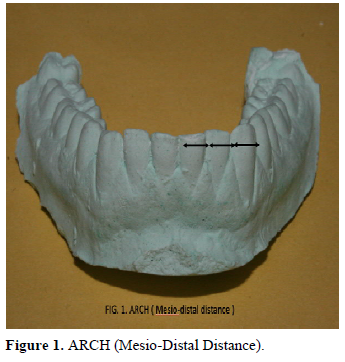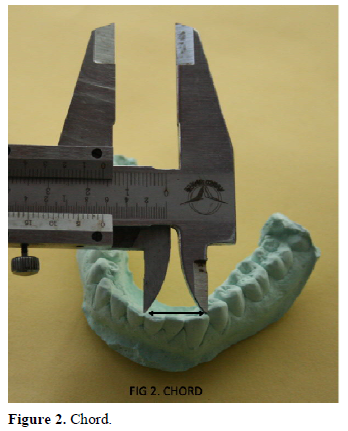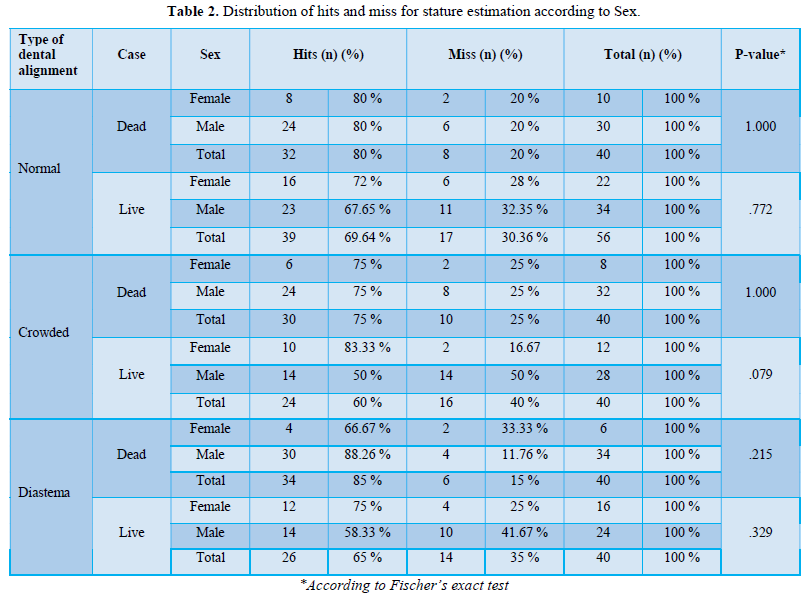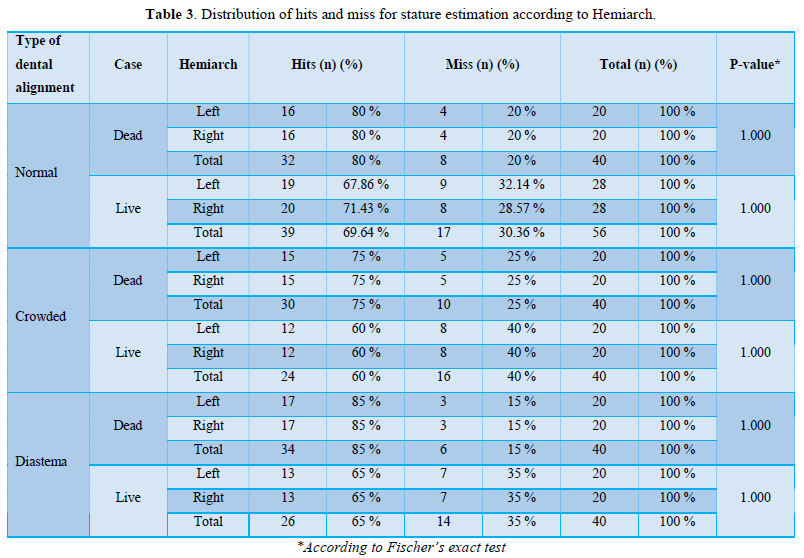Research Article
Stature Estimation by Carrea’s Index in Dead and Live Subjects
2893
Views & Citations1893
Likes & Shares
Background: Amongst the key parameters of identification, stature estimation is one of the important criteria in establishing the individuality. The human body parts grow in proportion to each other and have some correlation which can be used in medico-legal cases. Due to their strong and durable structure of dental tissues, they are frequently used for the purpose of identification in cases where only dental remains are recovered.
Material & Methods: This study was conducted on 128 subjects (68 live and 60 dead) to predict stature by using Carrea’s Index in a tertiary level hospital of India. A dental cast of mandibular arches of all of the subjects was prepared using alginate impression, customized dental impression trays and dental stone. The casts were considered separately and divided according to dental alignment into three groups (normal, crowded and diastema) and each of these hemiarch (right and left side) were measured with a divider caliper and millimeter scale.
Observations & Result: Amongst all the subjects, success rate in predicting sex was higher in the dead (maximum of 85% in Diastemal alignment) as compared to total live individuals (maximum of 69.64% in normal alignment). Furthermore, among the living, females showed higher hits (maximum of 83.33% in crowded alignment) as compared to males (maximum of 67.65 % in normal alignment). There was statistically non-significant difference (p value > 0.05) between both sexes or between right and left hemiarch.
Conclusion: We conclude that Carrea’s index is an easy and less time-consuming method for stature prediction where only dental remains are available as it showed moderately high reliability, particularly among the dead. We suggest that this research should be extended in various parts of India considering both dead and live subjects.
Keywords: Stature, Carrea’s index, Dental tissues, Dental chord, Dental arch
INTRODUCTION
Amongst the various parameters of identification, stature estimation irrefutably acts as a platform for establishing the identity of an individual [1,2]. After death, the measured height varies at different intervals, being slightly longer or shorter due to post mortem changes such as flaccidity, rigor mortis and decomposition. According to Trotter and Glesser [3], there is an average increase of about 2.5 cm in stature. It is in fact, a measure which varies considerably according to sex, ancestral background, nutrition, hormonal influence, body composition, climate and day length [4,5]. Stature is often estimated from various parts of the body measures, more commonly from the long bones [6-10]. However, in many investigations of human remains, not all the bones are present, possibly nothing but only the skull and mandible may be recovered. In such cases, the examination of skull and teeth becomes very important; stature of such person could be estimated reliably based on the proportionality with tooth dimensions [11-15]. In 1920, an Argentine author Juan Ubaldo Carrea described a series of relationship between the individual height and dimensions of face and head in his doctoral thesis [16]. In 1939, he developed a mathematical formula that allowed calculation of human stature by using the mandible in live individuals. Later on, other authors conducted studies on maxillary teeth as well, with satisfactory or unsatisfactory results [17,18]. To the best of our knowledge, there is limited literature available on these parameters, particularly in the Indian scenario. Hence, the present study is being conducted to estimate stature in both living as well the dead individuals by measuring the dimensions of the mandibular arch using Carrea’s index.
MATERIALS AND METHOD
A cross sectional observational study was conducted on 128 subjects (68 live and 60 dead), all above 18 years of age in a tertiary level hospital of India. The study was conducted both on volunteering live individuals and dead bodies brought to the mortuary for medico legal autopsy; consent was duly taken from the live volunteers and legal heirs of the deceased respectively after explaining the procedure and purpose of this study. Those cases having missing incisors, canines, any kind of dental restoration, braces, prosthetics and abnormalities of the spine were excluded from the study. A dental cast of mandibular arches of all of the subjects was prepared using alginate impression, customized dental impression trays and dental stone. Each hemi arch was then considered separately and divided according to dental alignment into three groups (normal, crowded and diastema). The Mesiodistal distance of each of these dental elements were measured by the use of a divider caliper and millimeter scale, the chord was measured with a vernier caliper as shown in Figures 1 & 2.




The stature of live individuals was measured by making the subject stand erect on a horizontal plane, barefooted in anatomical position and that of a dead body was measured by using a steel measuring tape in supine position. In accordance with the Carrea’s formula, using mm scale, the stature was calculated as below:
Maximum stature = Arch (in mm) x 3ΠMinimum Stature = Chord (in mm) x 3Π where,
Arch: Sum of the mesio-distal distance from labial surface of the central incisor, lateral incisor, and canine.
Chord: Distance measured from lingual surface on the same side between the mesial end of central incisor and distal end of canine. The findings that lay between the minimum and maximum stature were considered as HITS, others as a MISS. The entire data was compiled in an excel sheet and analyzed by the computer software, Statistical Package for the Social Sciences (SPSS) version 20.
OBSERVATION & RESULT
In our study, males outnumbered the females in both dead as well as live subjects. Considering the alignment in all cases, Normal teeth alignments were found to be maximum (37.5%) as compared to crowded (31.25%) and diastemal (31.25%) (Table 1).
After applying the carrea’s index, it was observed that dead subjects showed maximum hits as compared to the live individuals (Diastemal alignment showed maximum hit of 88.26% among the males) whereas in the living maximum hit of 83.33% was observed in crowded alignment of females. In both the cases, there was statistically non-significant difference between them as p value was more than 0.05 (Table 2).
In both dead as well as live cases, left and right hemiarch showed equal distribution of hits except in live subjects of normal alignment where more hits were observed on the right side (Right-71.43%, Left 67.86%). Also, there is statistically non-significant difference observed between them with an exceptionally high hit of 85 % in Diastemal alignment of Dead subjects (Table 3).






DISCUSSION
Various studies have been conducted considering measurement of only dental tissue parameters for stature estimation using Carrea’s method. [11,14,17-16,19-21]. However, all of these have been conducted only on live subjects and most of the authors have taken measurement of both mandibular as well as on maxillary anterior teeth either directly or by using a cast. To the best of our knowledge, present study is the first time when dead subjects have been included and compared with the findings of live individuals. In our study, among the living, highest as well as lowest hits were observed in crowded dental alignment (females showed highest hits of 83.33 % and males with lowest hits of 50%). Moreover, the dead subjects comparatively showed a higher success rate i.e., >75% as opposed to live subjects (total dead subjects showed a maximum hit of 85% observed in diastema as compared to maximum of 69.64% which was observed in normal alignment of total live subjects). Among these, highest as well as least hits were observed in diastemal alignment (88.26% in males and 66.67% in females respectively). The authors attribute this high percentage of hits in the dead to the measurement of all the dead subjects being taken during the rigor mortis stage but in live cases, there might be a possibility of diurnal variation. In 2007, [17] observed that modified Carrea’s method produced high success rate of 100.0% and 93.3% in males and females respectively as compared to the conventional method [18]. Whereas, in this study, the authors have used conventional Carrea’s method with an overall moderate success rate (>65%) except in male live subjects having crowded and diastema alignments where the success rate was relatively low (50% and 58.33% respectively). In 2008, Lima et al conducted a comparative study of mandibular teeth with maxillary teeth and found 100 % unsuccessful rate in maxillary dental alignments [20]. Our study is consistent with the mandibular findings of this study in which highest hits were observed in females with crowded alignment (95.2 %), on the right hemiarch (90 %) having statistically non-significant difference between them whereas a statistically significant difference was observed among the females with normal dentition and on left side. In another study conducted by the same author, only mandibular teeth were considered showing similar findings as the previous study (highest hits in females with crowded dentition) though very less hits were observed in diastema. [11]. Our study is inconsistent with findings of only few authors in which highest hits were observed in Normal dentition followed by crowded and least hits in Diastemal alignment. Among these, [21] found highest hits in normal alignment among the males (94.03 %) and on the left side (93.84%) with statistically significant difference [22,23] and also observed similar findings of highest hits in normal alignment [21-23].
CONCLUSION
The measurement of mandibular hemiarches among the living and the dead using Carrea’s index is a convenient, simple, easy and inexpensive method for stature estimation and can provide valuable information particularly among the dead when only dental remains are available. However, there should be inclusion of more data involving people belonging to different race and regions as the outcome varies according to different geographical background and genetic makeup. Furthermore, in India, there exists a lot of diversity in the population which mandates more meticulous research. Hence, for a better analysis, we suggest this study to be extended to a larger and varied population encompassing a wider age group.
- Byers SN (2007) Introduction to Forensic Anthropology. 3rd Boston: Allyn & Bacon.
- Krogman WM, Iscan MY (1986) Human skeleton in Forensic Medicine. 2nd Springfield, Illinois, U.S.A: Charles C. Thomas Pub Ltd. pp: 302-351.
- Saukko P, Knight B (2004) Knight’s forensic pathology. 3rd London: Arnold. pp: 103
- Coles RJ, Clements DG, Evans WD (1994) Measurement of height: practical considerations for the study of osteoporosis. Osteoporos Int 4(6): 353-356.
- Krenzer U (2006) Compendio de métodos antropológicos forenses para la reconstructción del perfil osteo-biológico. Guatelama. 1st Guatelama: Centro de Analisis Forenses Aplicadas.
- Galloway MA (1988) Estimating actual height in the older individual. J Forensic Sci 33(1): 126-136.
- Giles E, Hutchinson DL (1991) Stature and age-related bias in self-reported stature. J Forensic Sci 36(3): 765-780.
- Hauser R, Smolinski J, Gos T (2005) The estimation of stature on the basis of measurements of the femur. Forensic Sci Int 147(2-3): 185-190.
- Krishan K, Sharma A (2007) Estimation of stature from dimensions of hands and feet in a north Indian population. J Forensic Leg Med 14(6): 327-332.
- Singh R, Barwa J, Nanda R, Mamgain S, Sabharwal S, et al. (2017) Estimation of stature from percutaneous measurement of upper limb length by linear regression equation. Medico-Legal Update 17(2): 93-96.
- Carrea JU (1939) Talla individual human en función al radio cuerda. Ortodoncia 6: 225-227.
- Krishan K (2008) Estimation of stature from cephalo-facial anthropometry in north Indian population. Forensic Sci Int 181(1-3): 52-56.
- Lima L, Da costa Y, Tinoco R, Rabello P, Daruge E (2011) Stature estimation by Carrea’s index and its reliability in different types of dental alignment. J Forensic Odon 29(1): 7-13.
- Silva M (1990) Estimativa da estatura do indivíduo com autilização de um grupo de dentes da mandíbula. Rev Paul Odontol 12(4): 18-28.
- Singh R, Bhasin N, Barwa J, Das S (2019) Inter-canine width as a tool for sexual dimorphism and stature estimation. IJHRMLPI 5(2): 27-31.
- Carrea JU (1920) Ensayos Odontometricos. [Thesis]. Buenos Aires: Universidad Nacional de Buenos Ares.
- Anita P, Mandankumar PD, Sivasamy S, Balan IN (2016) Validity of Carrea’s Index in stature estimation among two racial population in India. J Forensic Dent Sci 8: 110.
- Wankhede KP, Kamdi NY, Parchand MP, Anjankar VP, Bardale RV (2012) Estimation of stature from maxillofacial anthropometry in central Indian population. J Forensic Dental Sci 4(1): 34-37.
- Cavalcanti AL, Porto A, Maia AMA, Melo TRNB (2007) Stature estimation by using the dental analysis: comparative study Between Carrea's and the modified methods. Rev Odontol UNESP 36: 335.
- Lima L, Rabello P, Nerve G (2008) Carrea’s index in dental students at the Federal University of Paraíba. Braz J Oral Sci 7(27): 1673-1677.
- Rekhi A, Marya CM, Nagpal R, Oberoi SS (2014) Estimation of stature in a young adult Indian population using the Carrea'sindex. J Forensic Ods 32(1): 15-23.
- Shruthi R, Reddy R, Nallakunta R, Jyothiramai K, Preethi M, et al. (2016) Carrea’s Index and Tooth Dimensions-An Avant-Garde in Stature Estimation: An Observational Study. J Clin Diagn 10(12): ZC33-ZC37.
- Rangari P, Singh U, Singh N, Kamdi SG (2018) Stature estimation and its reliability in different types of dental alignment using the Carrea’s Index. Int J Med Res Rev 6(3): 177-181.
QUICK LINKS
- SUBMIT MANUSCRIPT
- RECOMMEND THE JOURNAL
-
SUBSCRIBE FOR ALERTS
RELATED JOURNALS
- Dermatology Clinics and Research (ISSN:2380-5609)
- Oncology Clinics and Research (ISSN: 2643-055X)
- Journal of Immunology Research and Therapy (ISSN:2472-727X)
- Ophthalmology Clinics and Research (ISSN:2638-115X)
- International Journal of Anaesthesia and Research (ISSN:2641-399X)
- International Journal of Clinical Case Studies and Reports (ISSN:2641-5771)
- Stem Cell Research and Therapeutics (ISSN:2474-4646)



